
Oecophoridae is a family of small moths in the superfamily Gelechioidea. The phylogeny and systematics of gelechoid moths are still not fully resolved, and the circumscription of the Oecophoridae is strongly affected by this.

The Gelechiidae are a family of moths commonly referred to as twirler moths or gelechiid moths. They are the namesake family of the huge and little-studied superfamily Gelechioidea, and the family's taxonomy has been subject to considerable dispute. These are generally very small moths with narrow, fringed wings. The larvae of most species feed internally on various parts of their host plants, sometimes causing galls. Douglas-fir (Pseudotsuga) is a host plant common to many species of the family, particularly of the genus Chionodes, which as a result is more diverse in North America than usual for Gelechioidea.
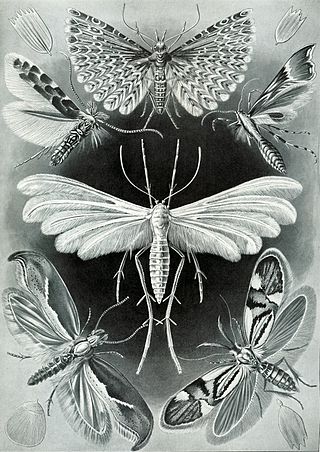
Microlepidoptera (micromoths) is an artificial grouping of moth families, commonly known as the "smaller moths". These generally have wingspans of under 20 mm, so are harder to identify by external phenotypic markings than macrolepidoptera. They present some lifestyles that the larger Lepidoptera do not have, but this is not an identifying mark. Some hobbyists further divide this group into separate groups, such as leaf miners or rollers, stem or root borers, and then usually follow the more rigorous scientific taxonomy of lepidopterans. Efforts to stabilize the term have usually proven inadequate.

Gelechioidea is the superfamily of moths that contains the case-bearers, twirler moths, and relatives, also simply called curved-horn moths or gelechioid moths. It is a large and poorly understood '"micromoth" superfamily, constituting one of the basal lineages of the Ditrysia.

The Coleophoridae are a family of small moths, belonging to the huge superfamily Gelechioidea. Collectively known as case-bearers, casebearing moths or case moths, this family is represented on all continents, but the majority are found in temperate areas of the Northern Hemisphere. They are most common in the Palearctic, and rare in sub-Saharan Africa, South America, and Australia; consequently, they probably originated in northern Eurasia. They are relatively common in houses, they seek out moist areas to rest and procreate.
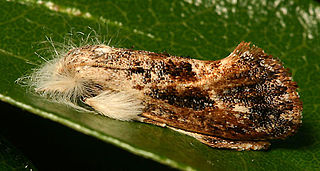
Acrolophinae is a family of moths in the order Lepidoptera. The subfamily comprises the burrowing webworm moths and tube moths and holds about 300 species in five genera, which occur in the wild only in the New World. It is closely related to the Tineidae family.
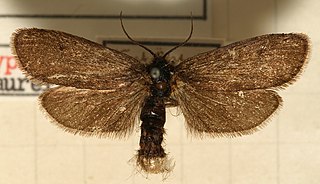
Lypusidae is an obscure family of moths placed in the superfamily Gelechioidea.

Scythrididae is a family of small moths in the superfamily Gelechioidea. The family is sometimes included in the Xyloryctidae as a subfamily Scythridinae, but the Xyloryctidae themselves have sometimes been included in the Oecophoridae as subfamily. Scythrididae adults are smallish to mid-sized moths, which when at rest appear teardrop-shaped.

The insect order Lepidoptera consists of moths, most of which are night-flying, and a derived group, mainly day-flying, called butterflies. Within Lepidoptera as a whole, the groups listed below before Glossata contain a few basal families accounting for less than 200 species; the bulk of Lepidoptera are in the Glossata. Similarly, within the Glossata, there are a few basal groups listed first, with the bulk of species in the Heteroneura. Basal groups within Heteroneura cannot be defined with as much confidence, as there are still some disputes concerning the proper relations among these groups. At the family level, however, most groups are well defined, and the families are commonly used by hobbyists and scientists alike.

Pseudatemelia flavifrontella is a species of gelechioid moths.
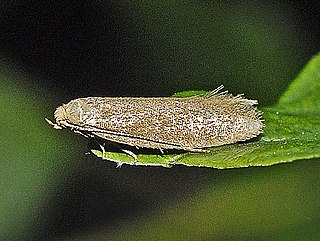
Pseudatemelia subochreella, the straw-coloured tubic, is a species of gelechioid moth.
Tineomigma is a genus of moths belonging to the family Tineidae.

Lypusa is a genus of moths of the Lypusidae family, traditionally held to be a monotypic lineage of Tineoidea. However, it may actually belong to the same lineage of Gelechioidea as the Amphisbatinae.
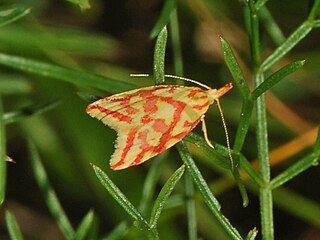
The Amphisbatinae was a small subfamily of moths in the superfamily Gelechioidea. Like their relatives therein, their exact relationships are not yet very well resolved. The present lineage is often included in the Depressariinae as a tribe Amphisbatini, though more often within the context of a "splitting" approach to Gelechioidea systematics and taxonomy, wherein the Depressariinae are elevated to full family rank and the Amphisbatinae are treated as a subfamily therein. An even more extremely split-up layout even treats the Amphisbatinae as full family Amphisbatidae. In the scheme used here, the Amphisbatinae are included in the Oecophoridae as a subfamily alongside the Depressariinae.

Pseudatemelia is a genus of gelechioid moths.

Philonome clemensella is a species of moth of the family Tineidae found in North America.
Paralypusa chinensis is a small moth in the family Lypusidae. It was found in eastern China in Zhejiang province.

The Harmacloninae are a subfamily of moth of the family Tineidae.
















